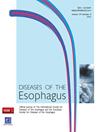586.唾液中胃蛋白酶对评估胃食管反流患者术后效果的价值
IF 2.3
3区 医学
Q3 GASTROENTEROLOGY & HEPATOLOGY
引用次数: 0
摘要
背景 本研究旨在评估唾液胃蛋白酶对胃食管反流(GERD)患者手术治疗效果的评估价值。方法 连续 45 名接受质子泵抑制剂治疗后仍患有胃食管反流的患者接受了腹腔镜抗反流手术(LARS)。术前和 3 个月随访时记录了 24 小时食管 pH 监测(MII-pH)和食管测压(HRM)数据。临床症状由胃肠道生活质量指数(GIQLI)评定,胃肠道症状由标准化症状清单(SCL)评估,该清单评估了 14 种不同症状的严重程度和强度。在进行 MII-pH 的同时,还为每位患者采集了 3 份唾液样本。治疗失败的定义是,尽管 DeMeester 评分正常,但 GIQLI 和 SCL 改善了 < 10 分。结果 在基线时,所有患者的 MII-pH 测量结果均为病态。此外,所有患者术后的 DeMeester 评分均正常(平均值为 7.10 ± 4.56)。十名患者被定义为治疗失败,胃蛋白酶浓度从平均值 198.73 纳克/毫升降至 186.00 纳克/毫升(p>0.05)。在被定义为治疗成功的患者中,胃蛋白酶的平均值从 205.83 ng/mL 降至 85.24 ng/mL(p<0.001)。结论 唾液胃蛋白酶可作为 LARS 治疗成功的标志物。然而,要得出确切的结论,还需要进行更大规模的研究。本文章由计算机程序翻译,如有差异,请以英文原文为准。
586. VALUE OF PEPSIN IN SALIVA TO ASSESS THE POSTOPERATIVE OUTCOME OF PATIENTS WITH GERD
Background The aim of this study was to evaluate the value of salivary pepsin to assess the outcome of surgical treatment of patients with gastroesophageal reflux (GERD). Methods Forty-five consecutive patients with GERD despite proton pump inhibitor treatment received laparoscopic anti-reflux surgery (LARS). 24-hour esophageal pH-monitoring (MII-pH) and esophageal manometry (HRM) data were documented preoperatively and at 3-month follow-up. Clinical symptoms were rated with the Gastrointestinal Quality of Life Index (GIQLI) and gastrointestinal symptoms were evaluated by a standardized symptom checklist (SCL), assessing the severity and intensitiy of 14 different symptoms. Simultaneous to MII-pH the collection of 3 saliva samples per patient was performed. Treatment failure was defined as improvement of GIQLI and SCL of < 10 points, despite showing a normal DeMeester score. Results At baseline, all patients showed a pathological MII-pH measurement. Furthermore, all patients showed postoperatively a normal DeMeester score (mean 7.10 ± 4.56). Ten patients were defined as treatment failures with a change of pepsin concentration from a mean value of 198.73 ng/mL to 186.00 ng/mL (p>0.05). In patients defined as treatment success, mean pepsin value decreased from 205.83 ng/mL to 85.24 ng/mL (p<0.001). Conclusion Salivary pepsin could be a marker for treatment success after LARS. However, larger studies are required to reach firm conclusions.
求助全文
通过发布文献求助,成功后即可免费获取论文全文。
去求助
来源期刊

Diseases of the Esophagus
医学-胃肠肝病学
CiteScore
5.30
自引率
7.70%
发文量
568
审稿时长
6 months
期刊介绍:
Diseases of the Esophagus covers all aspects of the esophagus - etiology, investigation and diagnosis, and both medical and surgical treatment.
 求助内容:
求助内容: 应助结果提醒方式:
应助结果提醒方式:


